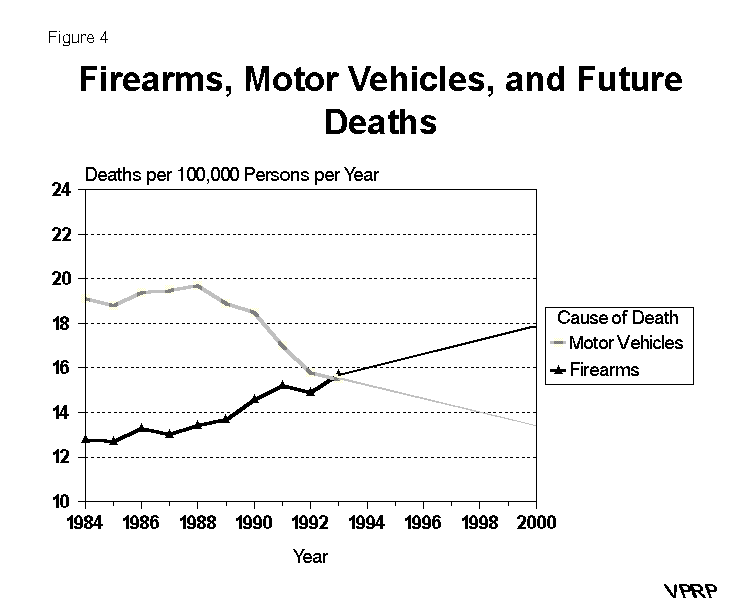Guns vs. Cars (and Drugs)
About 20 years ago, public-health researcher Garen J. Wintemute predicted that The Crossover was nigh: Soon, more Americans would be killed with guns than with motor vehicles.
He'd previously estimated that this would happen by 2004, and possibly as early as 1994. Now, looking at preliminary 1993 data from the CDC, he found that the two mechanisms of death were so close that the remaining difference was within the margin of error. And given current trends, it was "almost certain" that guns would be the leader for "some time":

Alas, the rest of the decade was not friendly to this prediction. The final 1993 estimates (available here), while close, were too far apart for the gap to be chalked up to error. In subsequent years, gun deaths — especially homicides — fell precipitously. In 2000, 47 percent more Americans died by motor vehicle than by gun.
You can never give up on a neat talking point, though. Last week, the Washington Post reported — with a chart sourced in part to one Garen Wintemute — that "for the first time in more than 60 years, firearms and automobiles are killing Americans at an identical rate." Indeed, we have a real statistical tie, with 33,736 motor-vehicle and 33,599 gun deaths on record. Thanks to a rising gun suicide rate — which canceled out a further decline in gun homicides so motor vehicles could catch up — the long-promised day has arrived. And with crime possibly on the rise, America having reached "peak car," and self-driving cars on the horizon, this time it might last.
I don't think it makes much sense to dump suicides, homicides, and accidents together into a single category — suicide and homicide especially are very different things, to the point that they tend to affect the opposite demographic groups (old vs. young, rural vs. urban, white vs. black). Nor is it clear what we learn when we compare deaths by gun (overwhelmingly intentional) with deaths by car (overwhelmingly accidental), unless we simply assume that, absent the gun lobby, regulations and lawsuits would reduce both to the same degree. But you have to admit that two decades' worth of patience paid off.
On a related (and more serious) note, there's another important fact in the CDC's new data: Drug overdoses are at a record high and have risen dramatically since the turn of the century. Here are the trends for all three of these phenomena (note the Y axis doesn't start at zero):

In fact, overdoses surpassed both cars and guns within the last decade, and show no signs of slowing down.
Robert VerBruggen is editor of RealClearPolicy. Twitter: @RAVerBruggen
Notes: Spreadsheet here, data from CDC's WONDER system. For guns and cars, I used the relevant "Injury Intent and Mechanism" categories in the CDC system. The drug numbers are based on the classifications featured in this CDC report; the numbers are even higher if you instead use the broader "Drug-Induced Causes" category.
For the sake of simplicity, the chart depicts the "crude" rates, but the spreadsheet includes the age-adjusted rates as well. Adjusting for age can make sense when comparing data across years or populations, though I'm not sure why you would do it to compare two types of death in a single year, as the Post does. To say that both rates were exactly 10.3 per 100,000 in 2014, they have to use numbers that are rejiggered to reflect the population as of 2000. The actual rates are 10.5 for guns and 10.6 for motor vehicles; each has a margin of error of plus or minus 0.1.




